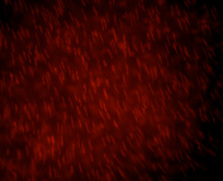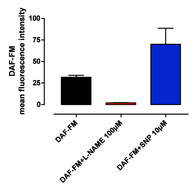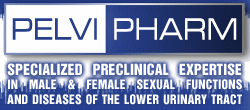Evaluation of tissue nitric oxide (NO) and superoxide (O2•-) release in situ using oxidative fluorescence
Objectives
Under conditions of oxidative stress, which are associated with aging and a variety of pathological events (including cardiovascular disorders) reactive oxygen species (ROS) production is dramatically increased, resulting in subsequent alteration of membrane lipids, proteins and nucleic acids. In this context, the balance between superoxide and NO release is of particular interest and could be evaluated using oxidative fluorescence.
The use of fluorescent probes in living tissue constitutes therefore, one of the best way to measure the production of ROS and to localize their formation.
Summarized methodology
Superoxide and NO production is evaluated in freshly harvested unfixed and unfrozen tissue.
Superoxide detection using dihydroethidium (DHE):
DHE is a cell-permeable probe which undergoes oxidation in the presence of superoxide leading to the formation of fluorescent ethidium which intercalates within the cell's DNA, staining its nucleus a bright fluorescent red (figure 1).
 |
| Figure 1: Representative microphotograph of DHE fluorescent staining observed on the endothelial face of rat aortic segments (Pelvipharm internal data). |
NO detection using DAF-FM (4-amino-5-methylamino-2',7'-difluoro fluorescein) diacetate:
DAF-FM diacetate is a membrane permeable dye that emits increased fluorescence after reaction with an active intermediate of NO formed during the spontaneous oxidation of NO to NO2- (figure 2).
 |
| Figure 2: Determination of DAF-FM fluorescence in the endothelium of thoracic aorta in control conditions or in presence of L-NAME 100µM or SNP 10 µM. |
Endpoints
- Baseline superoxide and NO tissue production
- Stimulated superoxide and NO tissue production using pharmacological agents
- Identification of the sources of superoxide production by the use of specific inhibitors (i.e. mitochondrial respiratory chain inhibitor rotenone; NADPH oxidase inhibitor diphenylene iodinium (DPI); cyclooxygenase inhibitor indomethacin; or xanthine oxidase inhibitor oxypurinol)
J Sex Med (2010) : 7(1)p1:79-88

Links to applicable Targeted disorders / Pathophysiological models
- Atherosclerosis
- BPH (Benign Prostatic Hyperplasia)
- Diabetes
- ED (Erectile Dysfunction)
- Ejaculatory disorders (premature or delayed ejaculation / anejaculation)
- FSD (Female Sexual Dysfunction)
- Hypertension
- IC (Interstitial Cystitis) / Painful bladder syndrome
- Metabolic Syndrome and Obesity
- Myocardial Infarction
- NDO (Neurogenic Detrusor Overactivity)
- OAB (Overactive Bladder)
- SCI (Spinal Cord Injury)





















 Download this page in PDF
Download this page in PDF